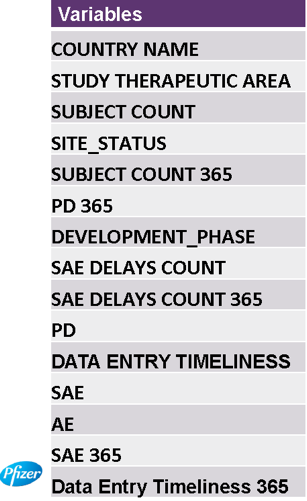How Pfizer Identifies and Tackles Clinical Trial Quality Events
We interviewed Pfizer exec, Dr. Jonathan Rowe, about how they are leveraging predictive models to manage study risk and quality.
Rowe

About a year ago, we interviewed Dr. Jonathan Rowe, Executive Director and Head of Clinical Development Quality Performance and Risk Management, at Pfizer about how they are leveraging predictive models to manage study risk and quality. Jonathan recently spoke at eXl’s CROWN Congress about how these models are fitting into a comprehensive clinical quality management, including risk mitigation processes and governance models. In this interview, Jonathan will provide more details on the topic.
Moe Alsumidaie: Can you elaborate on how Pfizer is managing clinical trial risk?Jonathan Rowe: We have implemented a model to be able to identify high-risk GCP studies based upon the outcome of our proactive quality risk management process. Once we have established the level of risk, there are several areas that we have automated to help us monitor emerging GCP risk. One of the areas that we look across is a suite of over 40 GCP metrics in order to flag and check if there is persistent underperformance in a study.

A second suite of data involves investigating changes in significant quality events and protocol deviation rates for all studies regardless of study size, number of patients enrolled, or sites activated; we are able to normalize what would be expected in that study, and if we start seeing an unusual trend, we are notified of the trend, and we initiate an investigation.
We have also implemented algorithmic models to detect and address risk to a study’s GCP performance due to site quality risk. Additionally, we have developed a cohort of leading indicators that correlate to future data risk, allowing time to correct course. These tools, along with other resources, enable early responses to potential GCP Quality issues.
MA:Can you elaborate on how Pfizer acts upon the GCP quality information, the governance model, and have you seen a measurable reduction in quality events?JR: These investigations into the GCP Quality information are supported by a clinical quality team, who are GCP subject matter experts. They will evaluate these indicators to determine how serious the GCP risk might be. Once these determinations are made by the GCP subject matter experts, if the GCP performance of a study requires escalation, it gets submitted through the governance process where the performance determinations get reviewed, discussed, and decisions are made. This model has been implemented for about three quarters now and it seems to be working very well. The governance process is really there to proactively identify and address potential issues and it has resulted in a measurable reduction of quality events. We hope to be able to report more details on the effectiveness of this in the future.
MA: How does Pfizer categorize and address Quality issues after they have been identified?JR: We usually categorize issues into quality events and significant quality events. All events are reviewed and addressed, but the severity of the quality event defines the escalation pathway. Significant quality events are adjudicated into two levels. The more rare, but most serious events, have an immediate fast-track process where management gets notified urgently and actions can be implemented with high priority. This fast track approach ensures that quality is restored as rapidly as possible in an optimized fashion. The process has been very effective.
When it comes to how the quality events are addressed and corrected, sometimes there are quality issues that are easily handled locally. For example, if we discover that the temperature for drug storage was off by a couple of degrees for a limited time period, this is a quality event, but one that typically can be handled locally through established SOPs. Then there are events that may be more significant, and need hands-on approaches, including root cause analysis, site compliance investigation, and/or a site audit.
MA: How does this entire system comply with the new ICH-E6 addendum?JR: Section 5.0 of the ICH-E6 addendum states that you need to have a quality management system. I am part of the Clinical Development Quality organization for Pfizer and we are accountable for, and have implemented a GCP Quality Management System that includes elements such as training, GCP process quality, deviation management, risk management, vendor oversight, audit and inspection readiness and GCP oversight policies. Additionally, Section 5.0.1 of ICH-E6 R2 describes the requirement to identify processes and data that are critical to ensure GCP. For this, we have a well-established integrated quality risk management planning process, where the teams will go through the identification of risks to critical processes and data at the study level. There are a number of core risks that teams have to evaluate, and there is a process for identifying unique risks in the study that is conducted through a central tool that we created. Section 5.0.2 involves risk identification where we identify risks on a systemic level; this is addressed with our analytical and process oversight governance models. Section 5.0.3 is about the likelihood of the events occurring, the extent they could be detectable, and the impact. We evaluate those factors for our risks, and through an established methodology, we assign our risks a risk priority number in our system. A risk priority number of over 160 requires mitigation and a detailed description in the quality management plan. Section 5.0.4 is about risk control where we make decisions on which risks require us to conduct our mitigation activities. This section also describes establishing quality tolerance limits. We have established integrated process leadership teams that will guide us in establishing the threshold settings. There is also a requirement for risk communication and review. Our communication goes through organized governance which facilitates addressing systemic risks in addition to the study level risks. Regarding study level risks, we review our risk management plans at predefined event occurrences in order to ensure that our quality management planning is effective and reflects the current state.
MA: What challenges have you experienced when implementing the ICH-E6 addendum?JR: We are comfortable with the majority of ICH E6 R2 updates in that we have been practicing them as part of our existing quality management system. The biggest challenge has been approaching the completely new areas of focus in the E6 revision from an inspection readiness perspective. We are working across many teams to ensure an aligned interpretation that will adhere to the requirements of ICH E6 R2.
Learn More at the 4th Annual Endpoint Adjudication Conference www.cbinet.com/endpoint and hear from FDA Senior Reviewer Andrew Farb, MD.
Moe Alsumidaie, MBA, MSF is Chief Data Scientist at Annex Clinical, and Editorial Advisory Board member for and regular contributor to Applied Clinical Trials.